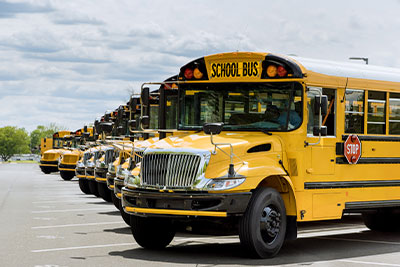Tips for Walkers, Bikers & Bus Riders

2025-09-10
 As the leaves begin to turn and the air gets a little crisper, the familiar rhythm of the school year returns. For many families, this means the daily commute to and from school. Whether your child walks, bikes, or takes the bus, ensuring their safety is paramount. Let’s dive into some essential tips to help make every journey a safe one.
As the leaves begin to turn and the air gets a little crisper, the familiar rhythm of the school year returns. For many families, this means the daily commute to and from school. Whether your child walks, bikes, or takes the bus, ensuring their safety is paramount. Let’s dive into some essential tips to help make every journey a safe one.
The Pedestrian Path: Walking to School
Walking to school is a fantastic way for kids to get some exercise and fresh air. But it also comes with responsibilities for both children and drivers.
- Practice the Route: Before school starts, walk the route with your child. Point out safe crossings, potential hazards, and where they should wait for traffic signals.
- “Stop, Look, and Listen”: This age-old advice is still the best. Teach children to stop at the curb, look left, right, and left again for traffic, and listen for approaching vehicles before crossing.
- Cross at Crosswalks: Emphasize using designated crosswalks, intersections with crossing guards, or traffic signals. Never dart out between parked cars.
- Be Visible: Dress children in bright colors, especially if they walk in the early morning or late afternoon. Reflective gear is a great addition.
- No Distractions: Teach children to put away phones and headphones while walking. Their full attention should be on their surroundings.
- Walk with a Buddy: If possible, encourage children to walk with a friend or a group. There’s safety in numbers.
Rolling Safely: Biking to School
Biking offers independence and fun, but cyclists need to be extra vigilant.
- Helmet Up! This is non-negotiable. A properly fitted helmet can prevent serious head injuries. Set the example by always wearing one yourself.
- Know the Rules of the Road: Bikes are vehicles, and riders must follow traffic laws. This includes stopping at stop signs and red lights, using hand signals for turns, and riding with the flow of traffic.
- Ride Predictably: Ride in a straight line, not weaving in and out of parked cars. Make eye contact with drivers to ensure they see you.
- Bike Maintenance: Regularly check tires, brakes, and chains. Ensure the bike is the right size for your child.
- Visibility is Key: Just like walkers, cyclists need to be seen. Bright clothing, reflective tape on bikes and helmets, and working front and rear lights (even during the day) are crucial.
Bus Stop Best Practices: Taking the School Bus
School buses are generally a very safe mode of transportation, but certain rules need to be followed at the bus stop and around the bus itself.
- Arrive Early: Be at the bus stop a few minutes before the bus is scheduled to arrive. This prevents rushing and potential hazards.
- Stay Out of the “Danger Zone”: Teach children that the area 10 feet around the school bus is the most dangerous. Never walk behind the bus, and if they drop something, they should tell the driver rather than retrieving it themselves.
- Wait Safely: Stand at least 10 feet back from the curb while waiting for the bus.
- Boarding and Exiting: Wait for the bus to come to a complete stop and the driver to signal it’s safe to board or exit. Use the handrail and avoid pushing.
- Cross in Front: If children must cross the street after exiting the bus, they should walk at least 10 feet in front of the bus, make eye contact with the driver, and wait for the driver’s signal before crossing. This ensures the driver can see them.
- No Distractions on the Bus: Once on the bus, children should remain seated, keep the aisle clear, and avoid distracting the driver.
A Note for Drivers: Share the Road Responsibly!
We all have a role to play in keeping children safe.
- Slow Down in School Zones: Obey posted speed limits, especially in areas where children are present.
- Watch for Walkers and Bikers: Be extra vigilant at intersections, crosswalks, and residential areas.
- Understand School Bus Laws: Remember the law: when a school bus has its red lights flashing and stop arm extended, traffic from both directions typically must stop. Be aware of your state’s specific laws regarding divided highways or multi-lane roads, but when in doubt, stop. The lives of children depend on it.
- Eliminate Distractions: Put away your phone. Focus 100% on the road and your surroundings.
Let’s work together to make this school year a safe and happy one for all our children. A little preparation and awareness can go a long way in protecting our most precious cargo.
If you’d like to learn more about how traffic violations may affect your insurance, reach out to Richard B. Ryon Insurance. Visit our website or contact us today.
Disclaimer: The information provided in this blog post is intended for general knowledge and informational purposes only, and does not constitute professional insurance advice. The content is not exhaustive and does not cover all potential situations. It is essential to review your specific insurance policy and discuss your individual circumstances with your insurance agent or broker. We strongly recommend that you consult with a qualified insurance professional to address your insurance needs and questions.
Source link



